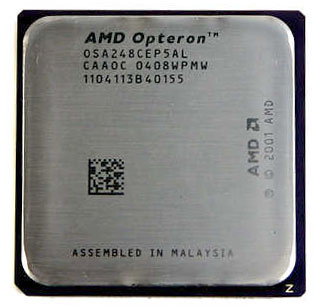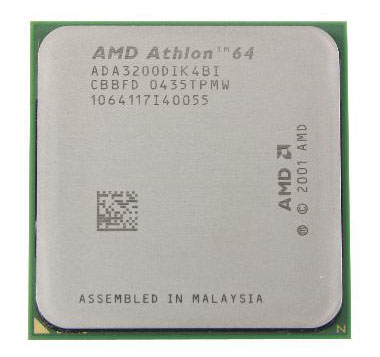Processor Obfuscation and You: An Update on AMD and Intel CPUs
by Kristopher Kubicki & Jarred Walton on May 17, 2005 12:00 PM EST- Posted in
- CPUs
Socket 939
The best alternative is all that remains, and that's Socket 939. With dual core Athlon 64 X2 chips planned at least through the 4800+ (2.4 GHz with 1MB L2), 939 has quite a lot of headroom remaining. At present, there are at least four variants of Athlon 64 processors for Socket 939, and two more are planned for the near future.
Newcastle was available for either 754 or 939 and used a 130nm process. Newcastle differs from Hammer primarily by the reduced L2 cache size and "CG" stepping. Since the 1MB cache was about half of the total CPU core, reducing the cache made the core substantially smaller and thus, cheaper to produce. What's interesting to note is that the Socket 939 CPUs had a huge price premium relative to their Socket 754 counterparts - a price premium that appears to be related to supply/demand and price/performance concerns more than anything else. Consider that both the 3400+ and 3500+ are basically identical, other than the socket. Both are 2.2 GHz 512K cache chips made on a 130nm process. However, the Athlon 64 3500+ carried a roughly 50% price premium. The end result is that Socket 939 chips tend to outperform their Socket 754 counterparts, due to the dual channel memory controller. The market basically dictates the prices that AMD and Intel can charge, and the market determined (with good reason) that Socket 939 was preferable to Socket 754.

Newcastle 3500+ models are still available at a discount relative to the newer 90nm parts, again most likely due to marketing factors rather than the actual cost to produce the chips. AMD may also be trying to clear out the old inventory before making it obsolete. The end result is that Winchester 3200+ and 3000+ parts are cheap and readily available, while the 3500+ Winchester costs quite a bit more than the 3500+ Newcastle. For most people, we'd either go with the cheaper and slower 90nm cores or make the jump to one of the higher performance 90nm cores; the 3500+ 90nm just isn't a very good bargain right now.
Generally, you can determine a processor is a Winchester CPU if the SKU ends in "BI". Winchester processors only utilize the "D0" stepping that we mentioned earlier, so don't expect SSE3 either. Although Winchesters are certainly a step up from the 130nm Newcastles, they are not the only 90nm chips around.

San Diego is the follow-up to Sledgehammer; the 1MB cache version of Venice. The new Athlon 64 3700+ and Athlon 64 4000+ parts use San Diego, as will the FX-57 when it's launched sometime in the next few months. San Diego chips have already begun to show up at retail (albeit in small quantities), and the prices are pretty attractive, for a high-end processor. Judging by the performance comparisons between Newcastle and Winchester, we would expect San Diego to outperform Sledgehammer clock for clock by a few percent - this is mostly due to caching algorithm optimizations, and the SSE3 additions are merely one more point in favor of the new core. We also expect the power consumption of San Diego to be significantly lower than Hammer, and quite a bit lower than Newcastle.
Venice and San Diego both use the "E" stepping cores, although there is actually a distinction between the steppings this time around. Venice, denoted by the "BP" at the end of the SKU, use the "E3" stepping. San Diego, on the other hand, use the "E4" stepping and are denoted by "BN" in the SKU.
Looking forward to later this year, we'll see the arrival of the Manchester and Toledo cores. Toledo is the dual core version of San Diego and it will power the Athlon 64 X2 4400+ and 4800+ parts (1024K L2 per core); the Manchester core will be used in the 4200+ and 4600+ (512K L2 per core), though we may also see "rejected" Toledo cores in those chips if the past is any indication. We've covered dual core performance in several recent articles: Intel Part I and Part II, along with the nForce4/855 comparison, and then the AMD Opteron and Athlon X2 articles. The basic summary is that anyone who runs a lot of applications at the same time - especially CPU intensive applications - will definitely benefit from dual core processors. The only fly in the ointment for AMD is that their dual core parts are currently targeting a much higher price range than their single core processors. In fact, the cost of a dual core chip like the 4200+ (2.2 GHz and 512K cache per core) is actually more than the cost of two 3500+ 130nm chips. That's definitely not the way to spur market adoption of dual cores, but it may be a business decision caused by the limited manufacturing capacity of AMD.
As a final topic that we didn't address yet, let's talk about overclocking for the various Socket 939 cores. Newcastle and Sledgehammer both top out around 2.5 GHz for the best chips, and many chips won't even reach that high. The heat and power requirements certainly play a role, although it's interesting that the FX-55 core with strained silicon added into the mix manages to run at 2.6 GHz, with overclocking attempts getting it as high as 3.0 GHz. The better choice for overclocking is definitely the 90nm parts. As usual, nothing is guaranteed with overclocking, and it's almost equal parts luck, components, and - for lack of a better term - artistry that determine your final clock speed. If you know what you're doing, we would venture to say that 2.5 GHz is achievable on all of the single core 90nm parts, though the 9X multiplier of the 3000+ may make it more difficult to reach. Early previews of the X2 chips are also showing results above 2.5 GHz, and when you think about it, it makes sense. The thermal density is actually the bigger problem with CPUs these days, so having a core that's twice as large in transistor count as well as die size basically means that the highest attainable clock speed (with a sufficient heat sink) will be similar. We won't know for sure until the retail launch when we can see results for more than a few hand-selected CPUs, but even without overclocking, the performance offered by the Athlon X2 is impressive.
Socket A

As for the individual cores, they all used 130nm process technology, and the maximum clock speed was similar - around 2.2 GHz. The added cache of the Barton core helped performance quite a bit, as did the increase in bus speed that came with the later parts. Modern Sempron chips for socket A use the Thoroughbred core, due to its smaller size. The one exception is the Sempron 3000+, which uses a Barton core clocked at 2.0 GHz. It's interesting to note that the Barton 2.0 GHz would have originally qualified as something like an Athlon XP 2800+, only 200 points below the Sempron rating. The Thoroughbred 2.0 GHz, on the other hand, was labeled as an Athlon XP 2400+ and later the Sempron 2800+, a difference of 400 points. Most of us realize that the performance ratings of the later Athlon XP chips were more marketing than reality. Joe Consumer figures a 3200+ is the same as a 3.2 GHz, right? The Sempron chips are now supposed to be compared with Intel's Celeron line rather than Pentium 4, and their model numbers seem to reflect true performance ratings better.










55 Comments
View All Comments
Tarumam - Tuesday, May 17, 2005 - link
BTW, thanks Kris & Jarred. This is just the kind of article that helps us readers to make the right decision. Much better read then those EE P4 or FX 59 dual core non sen$e...Tarumam - Tuesday, May 17, 2005 - link
I mean I don´t care about upgrade unless I realy need my system to do something faster or need it to do something the older can´t do at all. Who cares if I don´t have the fastest machine on the planet? All I want is a capable PC and I want to wear it out before the next leap.And save some cash doing that is just great!
Tarumam - Tuesday, May 17, 2005 - link
Well, what can I say? I use to love my socket A (XP 1700+ Via KT266A and Radeon 8500) as it was a screaming beast 4 years ago. when I bought it everyone was talking about how good and expensive P4 was. Now I just love my 754 3400+ in a small desktop (mAtx) as it does everything I need it to do very fast. The latest and gratest are there so I can build myself an incredible system (64 bit capable, lots of mem, SATA HD and a very decent 6600GT) for a reasonable bargain! Just love when some geek panics in distress: "OMFG my 939 single core is now obsolete! I gotta upgrade again...".JBird7986 - Tuesday, May 17, 2005 - link
My only issue with this article occurs with the statement that the "obscure" Socket 939 A64 3400+ is limited to an 800MHz HyperTransport link. Seeing as how I own one, and it is running at the full 1000MHz HyperTransport link, this seems to be a misstatement.Amplifier - Tuesday, May 17, 2005 - link
First